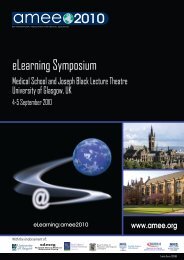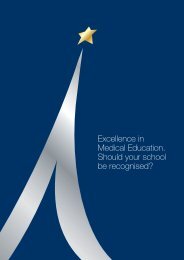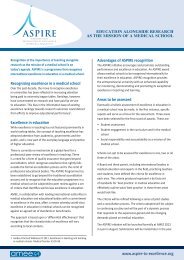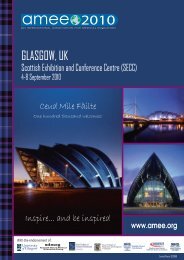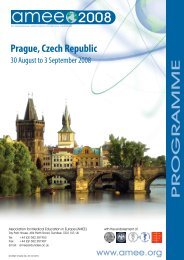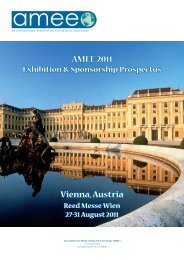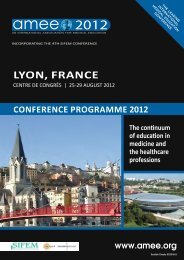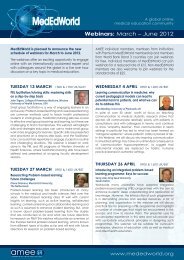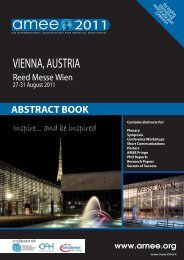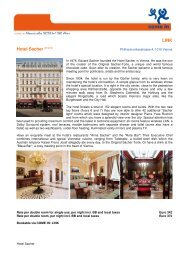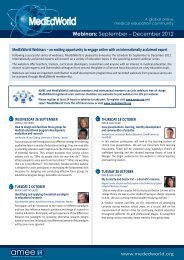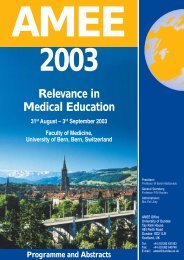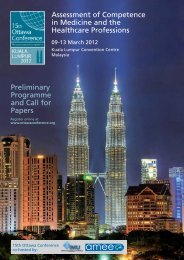AMEE Berlin 2002 Programme
AMEE Berlin 2002 Programme
AMEE Berlin 2002 Programme
Create successful ePaper yourself
Turn your PDF publications into a flip-book with our unique Google optimized e-Paper software.
8C4 ECTS (European Credit Transfer<br />
System) as a tool in curriculum<br />
development<br />
B Grether<br />
Veterinarmedizinische Fakultat der, Universitat Zurich,<br />
Winterthurerstr. 252, CH 8057 Zurich, SWITZERLAND<br />
The European credit transfer system is based on the<br />
total study workload of an average student. The “lecture<br />
per week” is no longer the measure for study workload;<br />
credits also allow the reflection of student time devoted<br />
to other learning activities such as e-learning, group<br />
work, directed self-study and time spent in skills labs.<br />
Whereas transferring an already existing curriculum<br />
into credits may be very difficult, ECTS can be a helpful<br />
tool when planning a new curriculum. The total amount<br />
of study workload will be defined for each course,<br />
including contact hours, pre- and post- course<br />
assignment, preparation for examinations and time<br />
necessary for various learning activities other than<br />
lectures. By attributing credits for this a balance of<br />
study workload over the whole course of study can be<br />
found. A credit system may also create an environment<br />
adequate for introducing new self-directed learning<br />
methods.<br />
8C5 The continuum of professional<br />
development<br />
H M R Meier<br />
University of Toronto, Mount Sinai Hospital, 600 University<br />
Avenue, Department of Psychiatry, Room 929, Toronto ON<br />
M5G 1X5, CANADA<br />
The first Elective provides the first step on the lifelong<br />
journey of professional development. This<br />
teaching-learning relationship offers additional<br />
dimensions for student and Tutor. Appropriate support<br />
for the Tutor’s professional contribution, including<br />
educational credits, enhances the spirit of the Electives<br />
programme and encourages experience in areas underrepresented<br />
or not yet represented in the core<br />
curriculum. Collaboration with CME and rural medical<br />
education includes conceptualisation of faculty<br />
development applicable beyond the Electives<br />
programme, as changes in core curriculum increasingly<br />
involve off-campus Tutors.<br />
Wednesday 5 September<br />
Session 8D The final examination<br />
8D1 Consistency of examination marks<br />
T Vik*, K H Karlsen and S Westin<br />
Norwegian University of Science & Technology, Department of<br />
Community Medicine, Medical Faculty, Olav Kyrres gt 3, N-<br />
7489 Trondheim, NORWAY<br />
To assess the consistency of examination marks, four<br />
examiners marked two cases given to 69 graduating<br />
medical students as part of the final board examination.<br />
- 4.87 -<br />
8C6 Evaluating ethics seminars<br />
Gerald Neitzke<br />
Department of History, Ethics & Theory of Medicine, Hannover<br />
Medical School (MHH), Carl-Neuberg - Str 1, D30623<br />
Hannover, GERMANY<br />
Teaching medical ethics involves teaching aims and<br />
objectives on different levels. On a cognitive level facts<br />
are taught to extend students’ knowledge. On an<br />
affective level emotions and conscience are dealt with<br />
to foster students’ attitudes and conduct. On the<br />
practical level skills are exercised to achieve sound<br />
moral judgement and decision-making, teamqualifications,<br />
and communication skills. If the<br />
effectiveness of ethics seminars is to be evaluated, all<br />
levels of teaching objectives have to be considered.<br />
Changes of attitudes and behaviour are key qualities<br />
of successful moral education. How can they be<br />
measured and what are fundamental conditions of such<br />
tests? Results should not be biased by students’ moral<br />
convictions. Behavioural changes should be<br />
distinguished from changes of attitudes only. A control<br />
group in a strict statistical sense has to be found. This<br />
presentation scrutinises the prerequisites of a standard<br />
of best evidence in ethics education.<br />
8C7 A tool to evaluate medical ethics<br />
seminars<br />
Mareike Moeller* and Gerald Neitzke<br />
Geibelplatz 4, 30173 Hannover, GERMANY<br />
The development and testing-phase of a survey to<br />
evaluate ethics seminars are presented. At Hannover<br />
Medical School one third of first year medical students<br />
get the chance to attend ethics classes. This offers the<br />
opportunity of an ideal study design with a randomised<br />
control group. The questionnaire is designed to test<br />
affective and practical components related to specific<br />
teaching aims. Attitudes like moral conscientiousness<br />
and empathy, and abilities like argumentation skills and<br />
decision-making are detected. The rationale is to<br />
measure students’ development in the handling of moral<br />
dilemmas before and after attending ethics classes.<br />
Students are confronted with two case histories which<br />
pose moral problems. A total of 16 statements (4 on<br />
each teaching objective) are to be approved/disapproved<br />
on a ratio scale. The pre-test took place already; the<br />
post-test will be carried out in July 2001. The<br />
questionnaire and preliminary results are presented.<br />
The marks were scored from 5 (failed) to 12 (excellent)<br />
and grouped in four categories: Failed, acceptable,<br />
good, and excellent. No student failed. Mean score<br />
given by one examiner (7.9; SD: 1.6) was significantly<br />
lower than that given by the other three (9.4; SD: 1.2).<br />
Correlation coefficients between examiners’ scores<br />
varied from 0.61 to 0.72 (p < 0.001). Agreement in<br />
classifying a student’s knowledge as acceptable, good<br />
or excellent varied from no (kappa: 0.04; 95% CI: -



